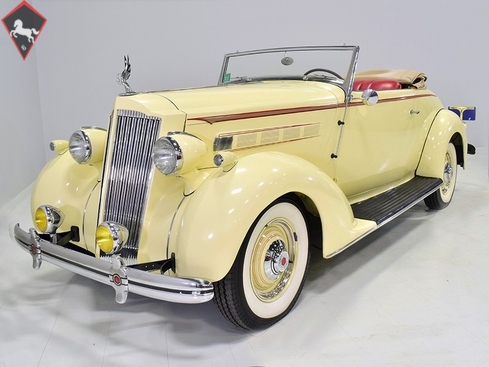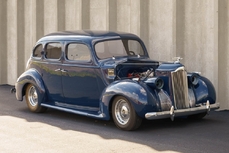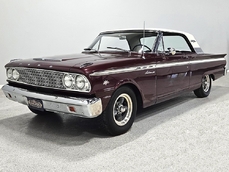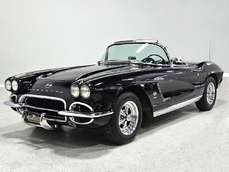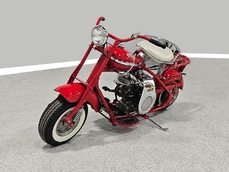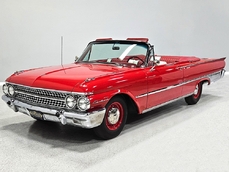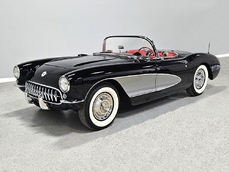Packard 120 282 cubic inch straight-8 1936
General description :
There are many who will credit the 120 with Packard's survival during the Great Depression, and that's surely a factor. However, even when they were new the 120s were still as expensive as a Buick and carried the same levels of quality and distinction as the larger Packards. Alone, it may not have been enough (the six-cylinder 110/115 series were likely a much bigger factor, a discussion we'll leave to the historians) but there's no denying that the Packard 120 is a significant car in many ways. It was the first Packard with hydraulic brakes, the first with an independent "Saf-T-Flex" front suspension, and it was sized in such a way as to appeal to a growing class of motorists: women. Ultimately Packard created what might just be the best-driving pre-war Packard of all, and that's not faint praise given the quality of the work coming out of their factories. If you like to slide behind the wheel and use a machine as intended, then this lovely 1936 Packard 120-B convertible coupe will delight you.
It would be a mistake to dismiss this gorgeous convertible because it's a "junior" Packard. The same quality, the same engineering, and the same look as the senior Packards make this 120 an extremely appealing car. Rumble seats were disappearing, but this one includes both a two-person rumble seat and a built-in trunk, so it's a surprisingly practical car for touring. Packard Cream was a popular color on these cars and it's exactly right—not yellow, not off-white, but a bold cream that stands out without being too dramatic about it. Red accents match the interior and trademark Packard hexagon emblems on the bumpers and hubcaps, and the familiar spear sweeping across the hood is finished in a darker tan just to add some interest. The restoration is probably 20 years old, but it is holding up remarkably well thanks to long-term care with a conscientious owner and his family, who continued to love and enjoy the car even after his passing. The paint shines up beautifully with only a few signs of use, the most noteworthy being a fingernail-sized chip on the inner edge of the left front fender—not really visible until you go looking for it and probably easy to touch up. You'll note that it has correct fender-mounted running lights, an accessory trunk rack out back, and the lovely Packard "cormorant" hood ornament leading the way. And yes, the view down the hood is as dramatic and wonderful as any of the more expensive models.
Most of the chrome was restored with the rest of the car and shows extremely well, including the bumpers and tall vertical grille slats. The windshield does not fold but is raked back at a dramatic angle and this is the rare convertible that looks equally good, top up or top down. Fog lights are mounted up front, and they closely match the shape of the headlights so they appear to belong there, while out back you'll find three steps leading to the rumble seat instead of the usual two, making it a bit more graceful for adults to climb inside. The rubber running boards were restored using correct patterns and they, too, are still in great shape.
Two years ago, the interior was restored using beautiful bright red leather and it shows extremely well. From the properly stitched and stuffed seats to the simple door panels and appropriately plush carpets, this car feels luxurious from within. The big banjo-style wheel makes this car surprisingly easy to handle (it was driven regularly by the owner's widow and daughter) and you'll quickly feel at home once you hit the road. The cream-colored gauges are all operational even with the car's unorthodox electrical system (more on this in a moment) and the optional AM radio does power up but does not make sound. There's also a fully operational heater under the dash as well as a hand choke for starting. Other controls designed to make this car an ideal traveling partner are the column-mounted turn signals (which are somehow self-cancelling—how'd they do that?) along with switches for an electric fuel pump and pusher fan on the front of the radiator. We believe the 10,236 miles showing on the odometer are since the 1990s restoration was completed. There's a fair amount of adjustment built into the front seat to make it comfortable for drivers of just about any size and the rumble seat, once you're in there, is equally spacious. The tan convertible top folds easily once you know the tricks and in the down position, it sits so neatly that a boot probably isn't necessary. There's also a fully finished trunk ostensibly designed to hold a spare tire (which is included) but the brand new Diamondback Radials are slightly taller than the stock tires so the spare doesn't quite fit.
The 1936 120 straight-8 received a small bump in displacement to 282 cubic inches, which translated to a rather healthy 120 horsepower and a big swell of that famous Packard straight-8 torque. Rebuilt at the time of restoration, this one starts easily and runs beautifully, pulling the convertible coupe around with ease and making it almost entirely unnecessary to shift out of high gear at anything but a dead stop. You will note a modern alternator installed on the driver's side of the engine, along with a 12-volt battery mounted on the firewall, both of which were added to the car's electrical system a few years ago to improve starting and to power the aforementioned electric fan. However, the car is NOT as 12-volt conversion, as the original 6-volt generator, wiring, and battery (under the driver's seat) are still in place. In essence, it is running two separate, distinct electrical systems. That means all the gauges work properly, the accessories and lights are all correct, and it still feels like a 1936 automobile. It will start using the original START button on the dash (6V) OR using a separate button under the dash (12V), and we have to admit that using 12 volts, it fires almost instantly. Once it's running, the 6V ignition takes over and thanks to having both a generator and an alternator, both batteries are charged as it runs. It's a rather clever setup that eliminates the sins of a 12-volt conversion while keeping the advantages. Nice!
Detailing is quite correct, with Packard Green on the block, an oil bath air cleaner, and single downdraft carburetor, and you can see that the workmanship was quite good when the restoration was finished. It is not a show car, of course, but it is certainly no slouch and it just sparkles on the open road. There's some heat shielding, which works with an electric fuel pump on the frame to alleviate the effects of today's fuels in old cars so it's a reliable runner. There's a minor exhaust leak somewhere under the heat shield by the carburetor, but it's only noticeable under heavy acceleration. It just purrs at idle and on the open road, it exhibits no bad habits, which is just what you'd expect from a Packard.
The Saf-T-Flex independent front suspension delivers the softy Packard ride that you would expect and the 3-speed manual transmission shifts easily with synchromesh on 2nd and 3rd. The chassis was nicely detailed at the time of restoration but shows the effects of 10,000 tour miles—some grunge but no rust, damage, or issues that need to be addressed. Of note, the engine splash pans are still in place (the often get tossed by lazy mechanics who don't understand their purpose), the springs are still wrapped in factory gaiters, and the familiar Packard hypoid rear axle is canted to allow a lower body line. There are 4.09 gears inside, which give this Packard comfortable cruising speeds with today's traffic. The brakes are firm and plenty adequate for the car's performance and it sits on brand new 700R16 Diamondback wide whitewall radials that completely transform the ride and handling. This is a car that begs you to get out and drive!
The car includes an owner's manual, matching spare tire and wheel, plus two extra 16-inch wheels.
This lovely Packard combines the most desirable body style (the rumble seat would disappear after 1937) with what are arguably the best road manners of any '30s car you can own. With spectacular colors, excellent care and maintenance, a few clever upgrades, and no issues, it is ready to tour. Take this 120 home and we're quite certain you will love the way it drives. Call today!
Harwood Motors welcomes and encourages personal or professional inspections of any vehicle prior to purchase.
http://www.harwoodmotors.com/vehicles/inventory_details.php?id=1069
1936 Packard 120 282 cubic inch straight-8 is listed sold on ClassicDigest in Macedonia by for $64900.
Car Facts
Car type : Car Make : Packard Model : 120 Model Version : 282 cubic inch straight-8 Engine size : 0.0 Model Year : 1936 Sub type : Convertible Location : Ohio
Sold
Seller Information
Sold
People who viewed this Packard 120 also viewed similar Packard listed at ClassicDigest
Other cars listed for sale by this dealer
About Packard
Packard: A Comprehensive HistoryEarly Years and Foundation:
Founding: The Packard Motor Car Company was established in 1899 in Warren, Ohio, by James Ward Packard, William Doud Packard, and George Lewis Weiss.
Pioneering Luxury: Initially producing high-quality automobiles, Packard became synonymous with luxury, craftsmanship, and engineering excellence.
Notable Achievements and Contributions:
Packard Twin Six: Introduced in 1916, this V12-powered car established Packard as a premier luxury automobile brand.
Model Line Expansion: Packard expanded its lineup with various models, including sedans, coupes, convertibles, and limousines, catering to affluent customers seeking elegance and performance.
Engineering Innovations: The brand introduced several innovations, such as the first use of aluminum pistons, air conditioning, and the Ultramatic automatic transmission.
Ten Historically Significant Models with Technical Specifications:
Packard Twin Six (1916):
Engine: 7.3L V12 engine.
Performance: Around 85 horsepower.
Packard Eight (1930-1938):
Engine: Straight-8 engine with various displacements.
Performance: Ranged from 90 to over 130 horsepower.
Packard Super Eight (1939-1951):
Engine: Straight-8 engine.
Performance: Produced between 130 to 180 horsepower.
Packard One-Twenty (1935-1942):
Engine: Straight-8 engine.
Performance: Approximately 100 to 120 horsepower.
Packard Clipper (1941-1957):
Engine: V8 engine.
Performance: Ranging from 135 to 185 horsepower.
Packard Caribbean (1953-1956):
Engine: V8 engine.
Performance: Varying between 275 to 310 horsepower.
Packard Patrician (1951-1956):
Engine: Inline-8 and V8 engines.
Performance: Ranged from 150 to 180 horsepower.
Packard Hawk (1958):
Engine: V8 engine.
Performance: Produced around 275 horsepower.
Packard Executive (1956-1958):
Engine: V8 engine.
Performance: Varying between 240 to 290 horsepower.
Packard Predictor (1956):
Engine: Concept car showcasing design and technology.
Performance: Prototype model.
Legacy and Influence:
Quality and Elegance: Packard was revered for its exceptional build quality, refined styling, and luxury features, often considered on par with European luxury brands like Mercedes-Benz.
End of Production: The brand faced financial struggles in the 1950s, leading to its merger with Studebaker and eventual discontinuation in the late 1950s, marking the end of an era in American luxury automobiles.
Packard left an enduring legacy in the automotive industry, symbolizing elegance, engineering excellence, and a commitment to luxury that has been admired and respected by car enthusiasts worldwide.
